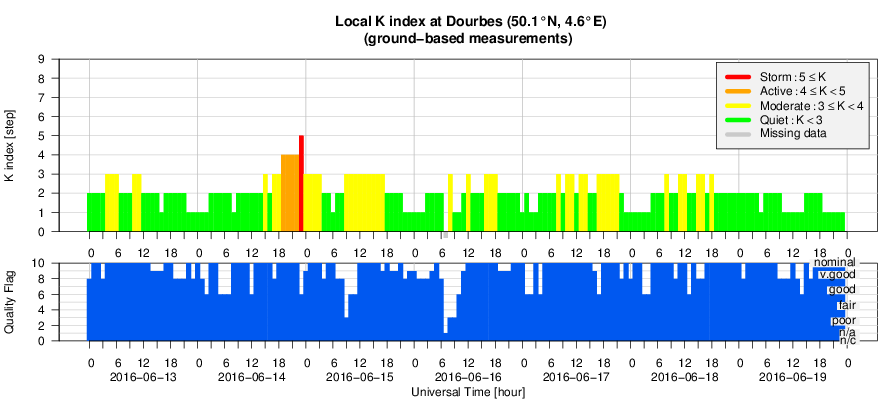- Table of Content
- 1.A long duratio...
- 2.Review of sola...
- 3.The Internatio...
- 4.PROBA2 Observa...
- 5.Review of geom...
- 6.Geomagnetic Ob...
- 7.Review of iono...
- 8.Future Events
- 9.New documents ...
2. Review of solar activity
3. The International Sunspot Number
4. PROBA2 Observations (13 Jun 2016 - 19 Jun 2016)
5. Review of geomagnetic activity
6. Geomagnetic Observations at Dourbes (13 Jun 2016 - 19 Jun 2016)
7. Review of ionospheric activity (13 Jun 2016 - 19 Jun 2016)
8. Future Events
9. New documents in the European Space Weather Portal Repository
A long duration geomagnetic storm
Early May, one small and one large coronal hole transited the solar disk's center. As expected, the associated high speed streams arrived at Earth just a few days later. Solar wind speeds up to around 700 km/s were recorded, with the interplanetary magnetic field directed southward ("negative" values) at moderate but persistent levels. In the SDO/AIA imagery underneath (from LMSAL at http://sdowww.lmsal.com/suntoday_v2/ ), the dark blue patches are the coronal holes, whereas the bright patches represent active regions.
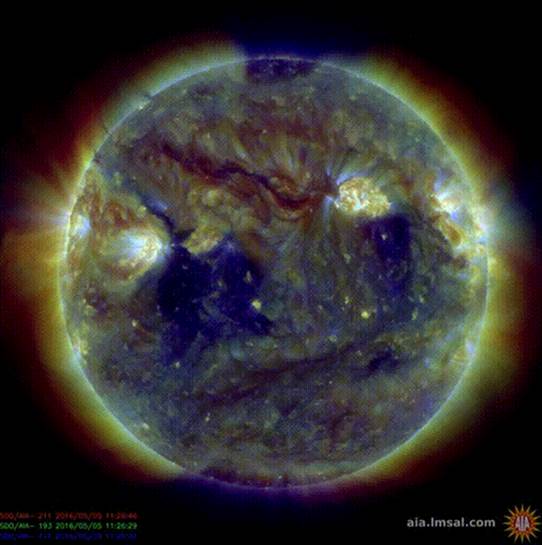
The Kp index is one of several parameters that is used to evaluate the level of disturbance of the Earth's magnetic field. It is a 3-hourly index varying from "0" (quiet) to "9" (extremely severe). See the 2014 news item at http://www.stce.be/news/243/welcome.html for more info. As it happened on 8 and 9 May 2016, the estimated Kp was 5 or higher for 9 consecutive 3-hour periods (27 hours!), as can be seen in the NOAA graph underneath.

Regular space weather observers immediately noticed this was not something that occurs frequently. A closer look was taken at the Kp values available at the World Data Center for Geomagnetism in Kyoto (http://wdc.kugi.kyoto-u.ac.jp/kp/index.html ), which has data since 1932. Any period with a Kp of 5- or higher was considered as geomagnetic storming. Note the Kyoto values may differ slightly from NOAA's daily estimated Kp (http://www.swpc.noaa.gov/products/planetary-k-index ), but it's not changing much the general conclusions.
Since 1996, there have been 35 intervals with 9 or more consecutive 3-hour periods of geomagnetic storming. Only 5 (five!) of those have occurred during the ongoing solar cycle 24 (SC24). Put in another way: We had 30 long duration storm intervals in 13 years (1996-2008, SC23), then only 5 in the last 7 years (SC24 so far). The previous intervals for SC24 were 7-8 October 2015 (10), 22-23 June 2015 (9; Solstice storm: http://www.stce.be/news/313/welcome.html ), 17-18 March 2015 (9; St-Patrick's day storm: http://www.stce.be/news/301/welcome.html ), and 15-16 July 2012 (10).
Since 1996, the longest interval occurred during the Halloween storms (29-31 October 2003), when no less than 20 (twenty) consecutive 3-hour periods of geomagnetic storming were recorded. The corresponding NOAA diagram has been attached underneath for comparison with that from early May 2016.

Since 1932, there have been only 13 intervals with 20 or more consecutive 3-hour periods of geomagnetic storming. The longest such interval apparently occurred in 1951, with geomagnetic storming raging from 19 till 23 September (31 consecutive 3-hour periods, that’s 93 hours!...). Clearly, we are not used anymore to such lengthy storming periods!
Review of solar activity
Solar activity was low throughout the week. Only two C-class flares were recorded. A C3.0 flare was produced by NOAA active region 2552 as it rounded the western solar limb on 13 June. Active region 2558 developed rapidly on disk over the weekend and produced a C1.7 flare peaking on 19 June at 11:58UT. The images underneath show both events in progress as observed in extreme ultraviolet by SDO/AIA 094.
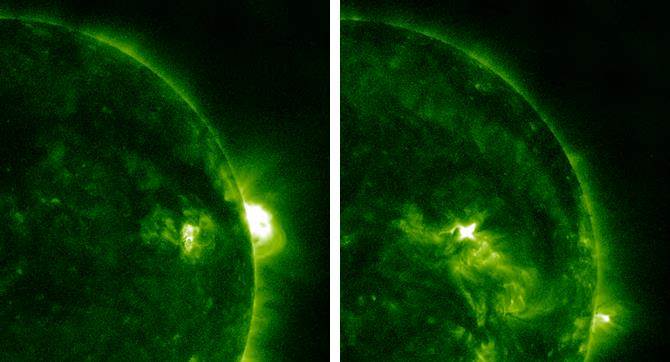
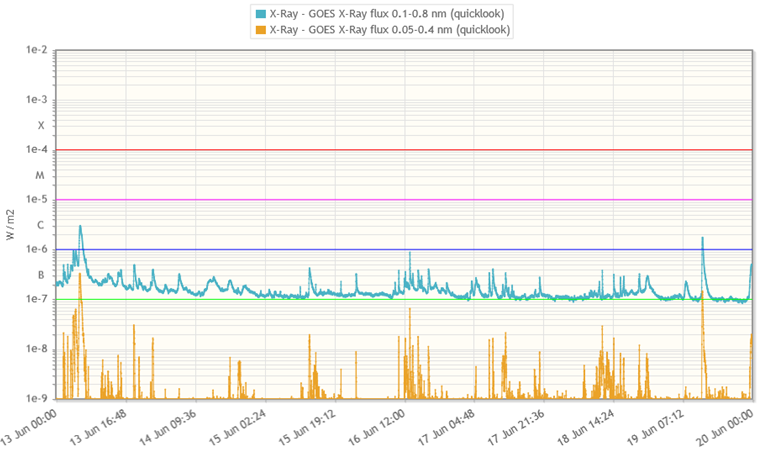
No earth-directed coronal mass ejections (CMEs) were observed during the week. The two most significant CMEs occurred early on 16 June. The first CME was related to a backside filament eruption (around 01:30UT), whereas the second CME most likely seems to have been associated with eruptive activity also on the Sun's backside around 07:00UT.
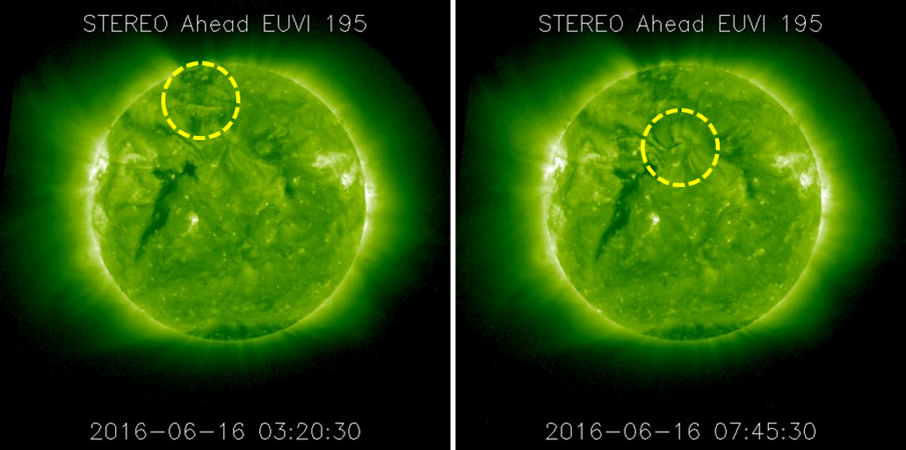
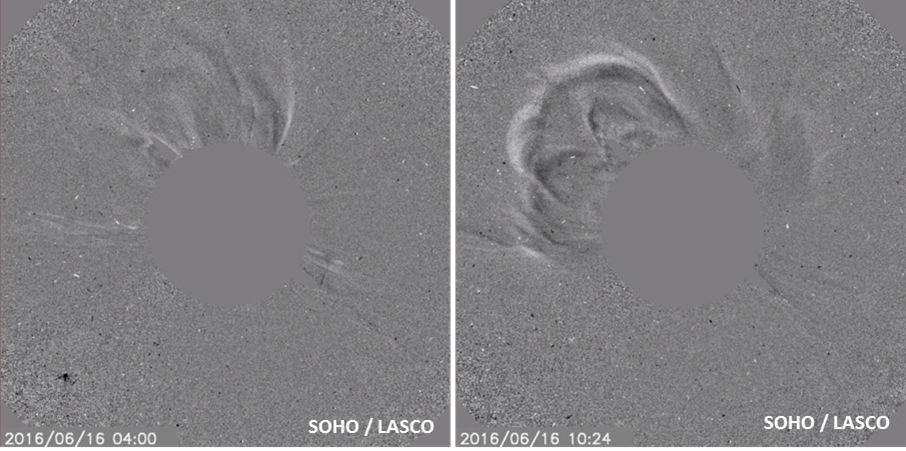
The International Sunspot Number
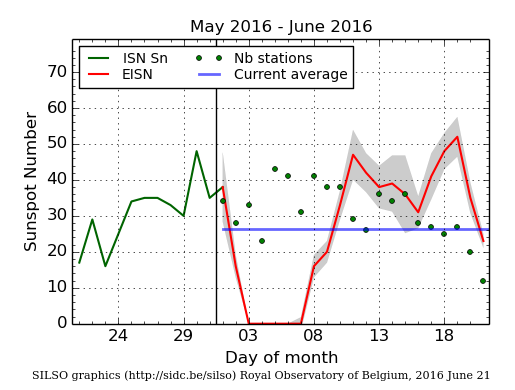
The daily Estimated International Sunspot Number (EISN, red curve with shaded error) derived by a simplified method from real-time data from the worldwide SILSO network. It extends the official Sunspot Number from the full processing of the preceding month (green line). The plot shows the last 30 days (about one solar rotation). The horizontal blue line shows the current monthly average, while the green dots give the number of stations included in the calculation of the EISN for each day.
PROBA2 Observations (13 Jun 2016 - 19 Jun 2016)
Solar Activity
Solar flare activity fluctuated between very low and low during the week.
In order to view the activity of this week in more detail, we suggest to go to the following website from which all the daily (normal and difference) movies can be accessed:
http://proba2.oma.be/ssa
This page also lists the recorded flaring events.
A weekly overview movie can be found here (SWAP week 325).
http://proba2.oma.be/swap/data/mpg/movies/weekly_movies/weekly_movie_2016_06_13.mp4
Details about some of this week's events, can be found further below.
Monday Jun 13
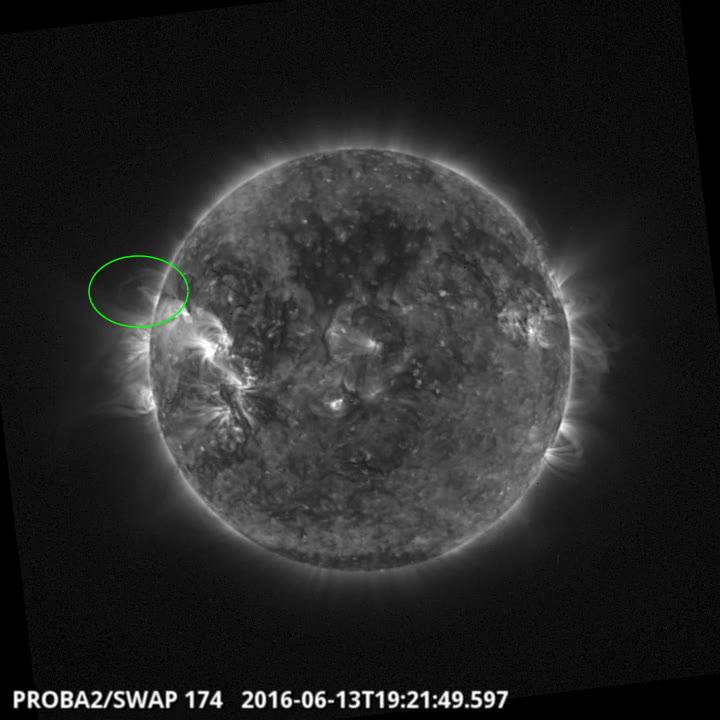
An eruption was observed by SWAP on the east limb of the Sun on 2016Jun13 at 19:49 UT
Find a movie of the events here (SWAP movie)
http://proba2.oma.be/swap/data/mpg/movies/20160613_swap_movie.mp4
Sunday Jun 19
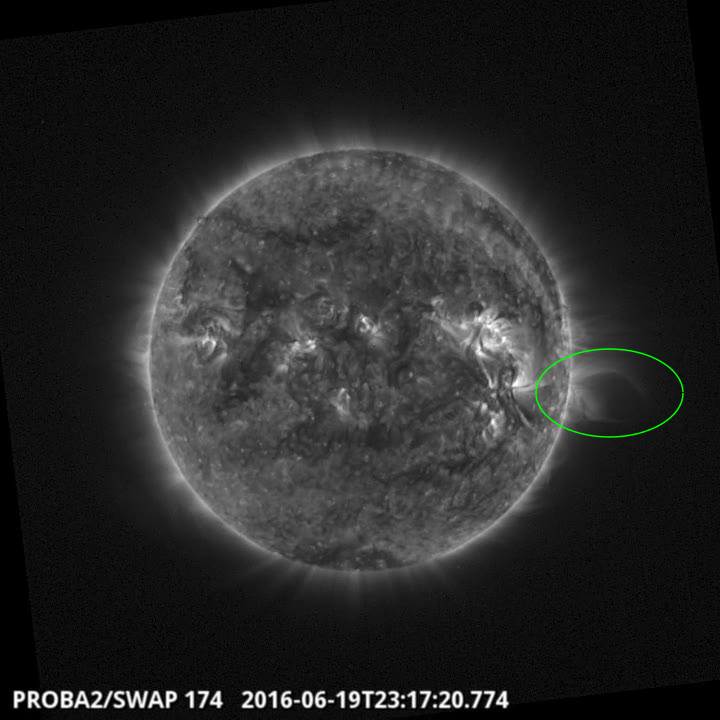
An eruption was observed by SWAP on the west limb of the Sun on 2016Jun19 at 23:17 UT
Find a movie of the events here (SWAP movie)
http://proba2.oma.be/swap/data/mpg/movies/20160619_swap_movie.mp4
Review of geomagnetic activity
Solar wind near Earth was dominated by the arrival of a high speed stream from a positive polarity coronal hole. Two positive polarity coronal holes crossed the central meridian on 12 June and either of those could be responsible for the observed solar wind enhancement.
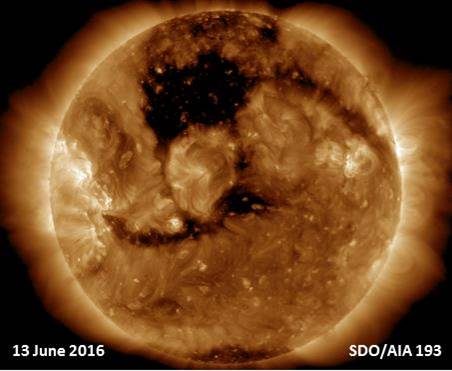
Solar wind conditions became elevated late on 14 June with solar wind speed reaching a peak of around 700 km/s early on 15 June (yellow curve underneath), and total magnetic field (white curve) reaching 15 nT with southward peaks of Bz to -14 nT (red curve). Total magnetic field recovered fairly quickly to nominal levels, but solar wind speed remained elevated throughout the remainder of the week. Consequently, NOAA Kp reached 6 (moderate geomagnetic storm conditions) and local K Dourbes 5 (minor geomagnetic storm conditions) late on 14 June and early on 15 June, but remained quiet to unsettled throughout the rest of the week.

Review of ionospheric activity (13 Jun 2016 - 19 Jun 2016)
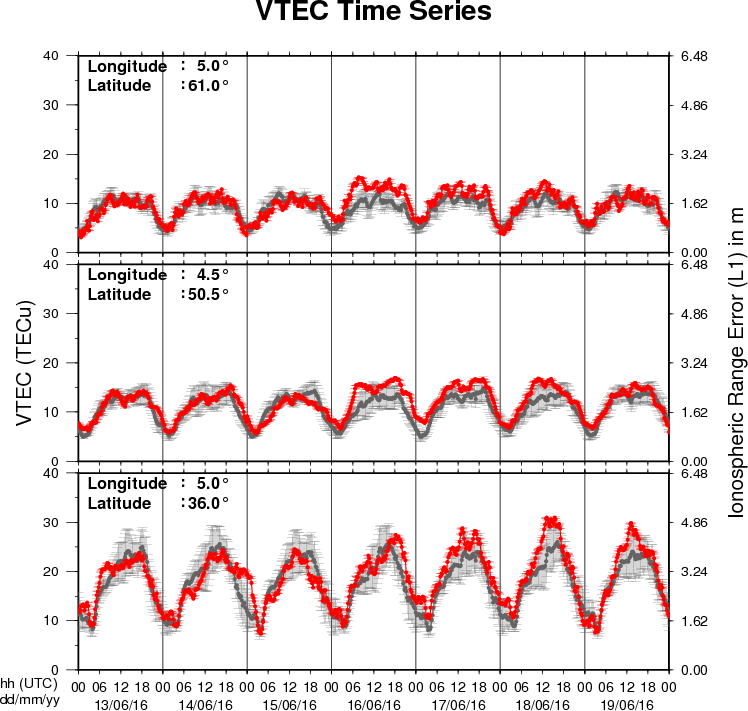
The figure shows the time evolution of the Vertical Total Electron Content (VTEC) (in red) during the last week at three locations:
a) in the northern part of Europe(N61°, 5°E)
b) above Brussels(N50.5°, 4.5°E)
c) in the southern part of Europe(N36°, 5°E)
This figure also shows (in grey) the normal ionospheric behaviour expected based on the median VTEC from the 15 previous days.
The VTEC is expressed in TECu (with TECu=10^16 electrons per square meter) and is directly related to the signal propagation delay due to the ionosphere (in figure: delay on GPS L1 frequency).
The Sun's radiation ionizes the Earth's upper atmosphere, the ionosphere, located from about 60km to 1000km above the Earth's surface.The ionization process in the ionosphere produces ions and free electrons. These electrons perturb the propagation of the GNSS (Global Navigation Satellite System) signals by inducing a so-called ionospheric delay.
See http://stce.be/newsletter/GNSS_final.pdf for some more explanations ; for detailed information, see http://gnss.be/ionosphere_tutorial.php
Future Events
For more details, see http://www.spaceweather.eu/en/event/future
The Scientific Foundation of Space Weather
Start : 2016-06-27 - End : 2016-07-01
Website:
http://www.issibern.ch/program/workshops.html
Global Modelling of the Space Weather Chain in Helsinki, Finland
Start : 2016-10-24 - End : 2016-10-28
This event brings together solar, heliospheric, magnetospheric,
and ionospheric communities to discuss the current state and future
challenges in global modelling of the entire space weather chain.
Major developments in forecasting space weather, and understanding
the effects of solar eruptions requires increased communication and
collaboration of these often rather distinct communities. We
welcome submissions from these modelling communities and also
synergetic studies utilising both observations and numerical
models.
Website:
https://pnst.ias.u-psud.fr/sites/pnst/files/global_modelling_space_weather_oct2016.pdf
European Space Weather Week in Ostend, Belgium
Start : 2016-11-14 - End : 2016-11-18
The ESWW is the main annual event in the European Space Weather
calendar. It is the European forum for Space Weather as proven by
the high attendance to the past editions. The agenda will be
composed of plenary/parallel sessions, working meetings and
dedicated events for service end-users. The ESWW will again adopt
the central aim of bringing together the diverse groups in Europe
working on different aspects of Space Weather.
Website:
http://www.stce.be/esww13/
Solar Orbiter Workshop 7: Exploring the solar environs in Granada, Spain
Start : 2017-04-03 - End : 2017-04-06
This event will be hosted by the Instituto de Astrofisica de
Andalucia - CSIC. Please mind that on April 7th the 20th SWT
meeting will take place at the same venue.
Website: Unkown
New documents in the European Space Weather Portal Repository
See http://www.spaceweather.eu/en/repository
STCE - Cosmic Rays workshop: A brief history of the cosmic ray monitoring at RMI
Presentation given at the Cosmic Rays workshop
Check https://events.oma.be/indico/event/10/
http://www.spaceweather.eu/en/repository/show?id=602
STCE - Cosmic Rays workshop: Introduction and Research topics
Presentation given at the Cosmic Rays workshop
check https://events.oma.be/indico/event/10/
http://www.spaceweather.eu/en/repository/show?id=603
STCE - Cosmic Rays workshop: The Neutronminitor database (NMDB) and its applications to space weather
Presentation given at the Cosmic Rays workshop
check https://events.oma.be/indico/event/10/
http://www.spaceweather.eu/en/repository/show?id=604
STCE - Cosmic Rays workshop: GLE alerts as input for SEP forecasts
Presentation given at the Cosmic Rays workshop
check https://events.oma.be/indico/event/10/
http://www.spaceweather.eu/en/repository/show?id=605
STCE - Cosmic Rays workshop: Cosmic rays and dosimetry at aviation altitudes
Presentation given at the Cosmic Rays workshop
check https://events.oma.be/indico/event/10/
http://www.spaceweather.eu/en/repository/show?id=606
STCE - Cosmic Rays workshop: Radiation hazards for astronauts
Presentation given at the Cosmic Rays workshop
check https://events.oma.be/indico/event/10/
http://www.spaceweather.eu/en/repository/show?id=607
